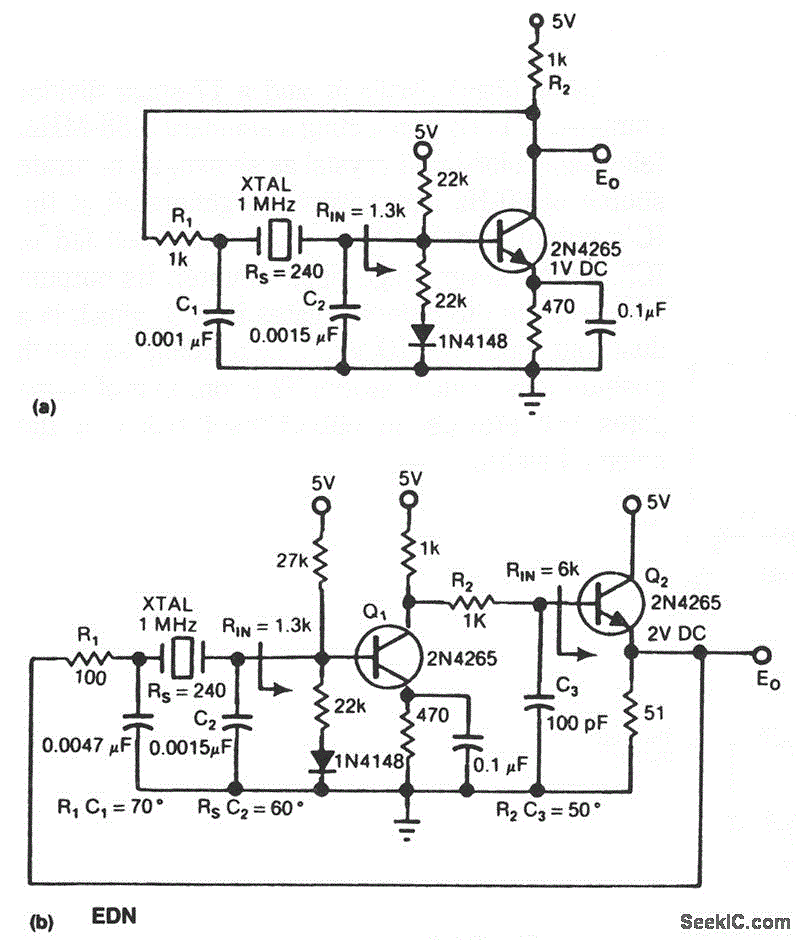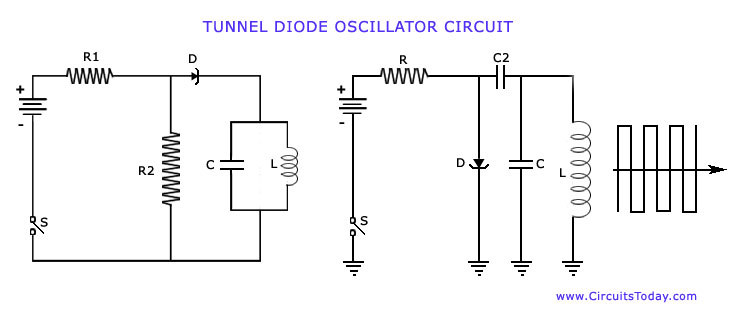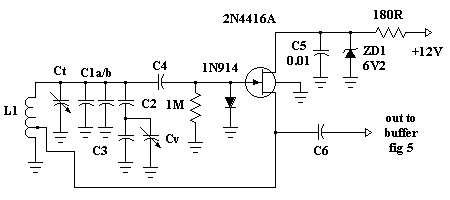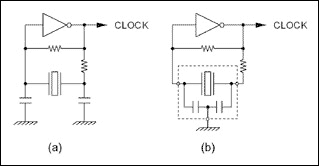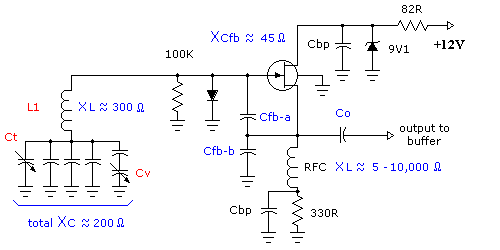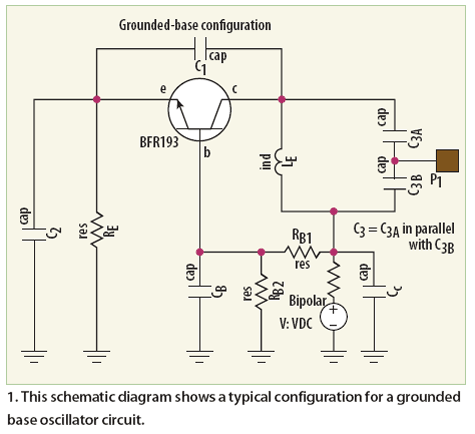
Oscillators and Mixers

The emergence of modern radio and radar systems has created a demand for stable harmonic oscillations at specific carrier frequencies to facilitate the necessary modulation and mixing conditions. While early carrier frequencies primarily operated in the low to mid MHz range, contemporary RF systems frequently exceed 1 GHz. This evolution has led to the requirement for specialized oscillator circuits that can deliver stable and pure sinusoidal signals. The complexity of oscillator design arises from the reliance on inherently nonlinear circuit behavior, which cannot be fully described using linear system tools. Specifically, small-signal linear circuit models for active devices have limited effectiveness in addressing the intricate feedback mechanisms involved. Additionally, since oscillators must supply power to subsequent circuits, frequency-dependent output loading can significantly influence performance. Consequently, designing oscillators is often more of an art than a precise engineering task, particularly in the high-frequency domain where parasitic components can greatly affect system performance. The presence of additional resonance effects from passive circuit elements may cause the oscillator to operate not only at the desired frequency but also at various harmonics, and in some cases, the oscillator may fail to function entirely. The initial section of this chapter focuses on negative resistance and feedback harmonic oscillators. After mastering the fundamental principles of generating oscillations, the discussion will progress to basic Colpitts and Hartley oscillators, followed by modern RF circuit design techniques that incorporate the S-parameters of active devices alongside various network configurations. The latter part of the chapter shifts focus to basic frequency translation tasks performed by mixers. Among the numerous mixer implementations for diverse applications, this chapter emphasizes downconverters. A common application of a mixer in a receiver system is the conversion of the RF input signal into a lower intermediate frequency signal, which is generally more amenable to subsequent signal conditioning and processing. This conversion is achieved by combining the RF input with a local oscillator signal through a multiplication operation that necessitates a nonlinear, at least quadratic, transfer function. Currently, transistors and diodes are employed, with modern FET technology enabling the construction of mixer circuits up to 100 GHz, while diode mixers can exceed the 100 GHz threshold.
The design of oscillator circuits is critical for maintaining the stability and purity of the signals required in RF applications. Oscillators can be categorized into various types, with negative resistance and feedback oscillators being notable for their ability to generate stable oscillations. Negative resistance oscillators exploit the characteristics of certain active components that exhibit negative resistance regions, allowing for sustained oscillation under appropriate conditions. Feedback oscillators, on the other hand, utilize positive feedback to reinforce the signal, leading to oscillation at a specific frequency determined by the circuit's reactive elements.
Colpitts and Hartley oscillators are two fundamental designs that illustrate the principles of oscillator operation. The Colpitts oscillator employs a capacitive voltage divider for feedback, while the Hartley oscillator utilizes an inductive divider. Both designs are characterized by their ability to produce low-distortion sinusoidal outputs and are widely used in various RF applications.
In addition to oscillators, mixers play a vital role in RF systems by facilitating frequency translation. The downconverter mixer is particularly important, as it converts high-frequency RF signals to lower intermediate frequencies suitable for further processing. The mixer achieves this by combining the RF input with a local oscillator signal, resulting in the generation of sum and difference frequencies. The choice of mixer architecture, whether based on diode or transistor technology, can significantly impact the performance parameters, including conversion gain, linearity, and bandwidth.
Overall, the complexities involved in the design of oscillators and mixers underscore the need for a deep understanding of both linear and nonlinear circuit behaviors, as well as the influence of parasitic elements at high frequencies. As RF technology continues to advance, the development of innovative circuit designs will be essential to meet the evolving demands of modern communication systems.With the advent of modern radio and radar systems came the need to provide stable harmonic oscillations at particular carrier frequencies to establish the required modulation and mixing conditions. While the carrier frequencies in the early days mostly reached into the low to mid MHz range, today`s RF systems easily surpass the 1 GHz point.
This h as resulted in the need for specialized oscillator circuits capable of providing stable and pure sinusoidal signals. What makes the design of oscillators such a difficult task is that we exploit an inherently nonlinear circuit behavior that can only be described incompletely with linear system tools.
Specifically, the small-signal linear circuit models utilized to represent the active device afford limited capabilities to handle the complicated feedback mechanism. Moreover, since an oscillator has to provide power to subsequent circuits, frequency-dependent output loading often plays an important role.
For these reasons, the design process for oscillators remains more of an art than an exact engineering design task. This holds particularly true for the high-frequency regime, where parasitic component influences can significantly impact the overall system performance.
Affected in part by the additional resonance effects of the passive circuit elements, it is possible that the oscillator operates not only at the intended frequency, but also at lower or higher harmonics. Certain system realizations may even cease to oscillate completely. In the first part of this chapter, we concentrate on the negative resistance and feedback harmonic oscillators.
Once the fundamental idea of how to generate oscillations is mastered, we investigate the basic Colpitts and Hartley oscillators before moving to the modern RF circuit design approaches involving the S-parameters of the active device in conjunction with the various network configurations. In the second part of this chapter, we turn our attention to the basic frequency translation tasks performed by mixers.
Of the many different mixer implementations for a wide range of applications, the main emphasis in this chapter is placed on downconverters. A typical application of a mixer in a receiver system is to convert the RF input signal into a lower intermediate frequency signal that is generally more suitable for subsequent signal conditioning and processing.
This conversion is accomplished by combining the RF input with a local oscillator signal as part of a multiplication operation that requires a nonlinear, at least quadratic, transfer function. Nowadays, transistors and diodes are in use, with present FET technology permitting the construction of mixer circuits up to 100 GHz, and diode mixers well exceeding the 100 GHz mark.
🔗 External reference
The design of oscillator circuits is critical for maintaining the stability and purity of the signals required in RF applications. Oscillators can be categorized into various types, with negative resistance and feedback oscillators being notable for their ability to generate stable oscillations. Negative resistance oscillators exploit the characteristics of certain active components that exhibit negative resistance regions, allowing for sustained oscillation under appropriate conditions. Feedback oscillators, on the other hand, utilize positive feedback to reinforce the signal, leading to oscillation at a specific frequency determined by the circuit's reactive elements.
Colpitts and Hartley oscillators are two fundamental designs that illustrate the principles of oscillator operation. The Colpitts oscillator employs a capacitive voltage divider for feedback, while the Hartley oscillator utilizes an inductive divider. Both designs are characterized by their ability to produce low-distortion sinusoidal outputs and are widely used in various RF applications.
In addition to oscillators, mixers play a vital role in RF systems by facilitating frequency translation. The downconverter mixer is particularly important, as it converts high-frequency RF signals to lower intermediate frequencies suitable for further processing. The mixer achieves this by combining the RF input with a local oscillator signal, resulting in the generation of sum and difference frequencies. The choice of mixer architecture, whether based on diode or transistor technology, can significantly impact the performance parameters, including conversion gain, linearity, and bandwidth.
Overall, the complexities involved in the design of oscillators and mixers underscore the need for a deep understanding of both linear and nonlinear circuit behaviors, as well as the influence of parasitic elements at high frequencies. As RF technology continues to advance, the development of innovative circuit designs will be essential to meet the evolving demands of modern communication systems.With the advent of modern radio and radar systems came the need to provide stable harmonic oscillations at particular carrier frequencies to establish the required modulation and mixing conditions. While the carrier frequencies in the early days mostly reached into the low to mid MHz range, today`s RF systems easily surpass the 1 GHz point.
This h as resulted in the need for specialized oscillator circuits capable of providing stable and pure sinusoidal signals. What makes the design of oscillators such a difficult task is that we exploit an inherently nonlinear circuit behavior that can only be described incompletely with linear system tools.
Specifically, the small-signal linear circuit models utilized to represent the active device afford limited capabilities to handle the complicated feedback mechanism. Moreover, since an oscillator has to provide power to subsequent circuits, frequency-dependent output loading often plays an important role.
For these reasons, the design process for oscillators remains more of an art than an exact engineering design task. This holds particularly true for the high-frequency regime, where parasitic component influences can significantly impact the overall system performance.
Affected in part by the additional resonance effects of the passive circuit elements, it is possible that the oscillator operates not only at the intended frequency, but also at lower or higher harmonics. Certain system realizations may even cease to oscillate completely. In the first part of this chapter, we concentrate on the negative resistance and feedback harmonic oscillators.
Once the fundamental idea of how to generate oscillations is mastered, we investigate the basic Colpitts and Hartley oscillators before moving to the modern RF circuit design approaches involving the S-parameters of the active device in conjunction with the various network configurations. In the second part of this chapter, we turn our attention to the basic frequency translation tasks performed by mixers.
Of the many different mixer implementations for a wide range of applications, the main emphasis in this chapter is placed on downconverters. A typical application of a mixer in a receiver system is to convert the RF input signal into a lower intermediate frequency signal that is generally more suitable for subsequent signal conditioning and processing.
This conversion is accomplished by combining the RF input with a local oscillator signal as part of a multiplication operation that requires a nonlinear, at least quadratic, transfer function. Nowadays, transistors and diodes are in use, with present FET technology permitting the construction of mixer circuits up to 100 GHz, and diode mixers well exceeding the 100 GHz mark.
🔗 External reference
